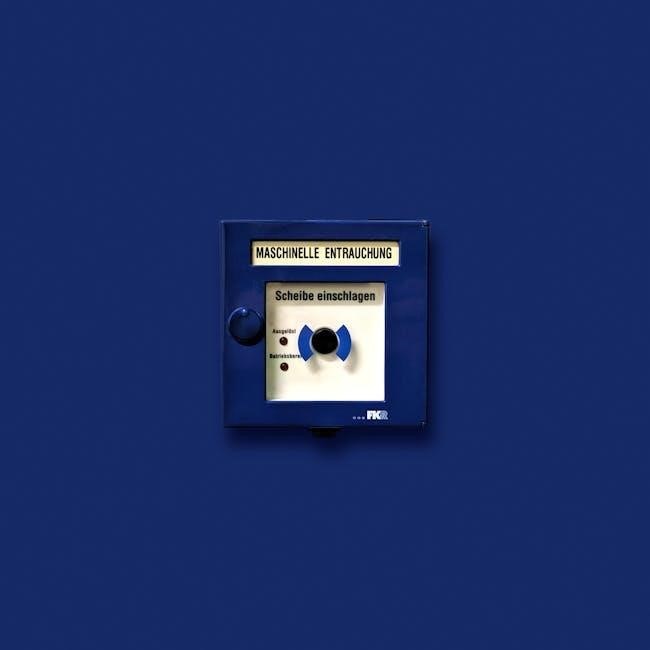Welcome to the Honeywell Alarm Keypad User Manual! This guide provides comprehensive instructions for the Honeywell 6150 and 6160 keypads, ensuring optimal system operation and user satisfaction.
Overview of the Honeywell 6150 and 6160 Keyboards
The Honeywell 6150 and 6160 keypads are advanced alphanumeric devices designed for Honeywell security systems. The 6150 is a wireless keypad, while the 6160 is a hardwired option, both offering a 2-digit numeric display for zone identification. They feature English-language prompts for easy navigation and are compatible with Honeywell’s security systems. These keypads are user-friendly, with clear instructions and customizable function keys. The 6150RF model supports wireless capabilities, including up to eight wireless keys. Both models are designed for durability and ease of use, ensuring reliable performance for home or business security needs. Refer to the installation manual for detailed setup instructions.
Importance of Understanding the User Manual
Understanding the Honeywell Alarm Keypad User Manual is crucial for maximizing the security system’s functionality. The manual provides detailed instructions for installation, operation, and troubleshooting. It helps users navigate features like arming modes (Away and Stay), zone identification, and error resolution. Familiarity with the manual ensures correct system arming, disarming, and maintenance, preventing false alarms and security breaches. It also guides users through advanced features, such as customizing function keys and integrating with home automation systems. Regularly reviewing the manual helps users stay updated on software updates and optimal system care, ensuring long-term reliability and user satisfaction.

Key Features of the Honeywell 6150 and 6160 Keyboards
The Honeywell 6150 and 6160 keypads offer advanced security features, including a 2-digit numeric display, English-language prompts, and wireless capabilities for seamless functionality and user convenience.
2-Digit Numeric Display for Zone Identification
The Honeywell 6150 and 6160 keypads feature a 2-digit numeric display, simplifying zone identification. This display provides clear visual feedback, showing zone numbers during alarms or system checks. It ensures that users can quickly identify which area of their property is affected, enhancing security management. The display is easy to read, even from a distance, and works in conjunction with English-language prompts for intuitive operation. This feature is particularly useful for users who prefer a straightforward, visually oriented interface to monitor their security system effectively.
English-Language Prompts for Easy Navigation
The Honeywell 6150 and 6160 keypads offer English-language prompts, making system navigation straightforward and user-friendly. These prompts guide users through various functions, such as arming, disarming, and checking system status. Clear instructions like “ARMED,” “AWAY,” and “STAY” reduce confusion, ensuring that even less experienced users can operate the system with confidence. This feature enhances accessibility and streamlines interactions, making it easier to manage home security effectively. The intuitive design of these prompts aligns with the overall simplicity of the keypads, providing a seamless experience for all users.
Wireless Capabilities and Compatibility
The Honeywell 6150RF keypad supports wireless functionality, offering enhanced flexibility and convenience. It is compatible with wireless keypads like the 5828 and 5828V, allowing seamless integration into your security system. Up to eight wireless keys can be programmed directly into the 6150RF without occupying additional zones. This feature simplifies installation and expands the system’s reach, ensuring reliable performance across your property. The keypad’s wireless capabilities are designed to work harmoniously with Honeywell’s security ecosystem, providing a robust and interconnected solution for modern home protection needs. This ensures a comprehensive and efficient security setup tailored to user preferences.

Installation and Setup of the Honeywell Alarm Keypad
The Honeywell 6150RF keypad is easy to install and blends seamlessly with any decor. This guide provides detailed steps for configuring and setting up your system effectively.
Mounting the Keypad

Mounting the Honeywell 6150 or 6160 keypad securely is crucial for optimal functionality. Choose a location with clear visibility and easy access. Ensure the surface is flat and dry. Use the provided screws or adhesive strips to attach the keypad. For wireless models, avoid metal walls to maintain signal strength. If using a desk mount, position it at a comfortable height. Follow the installation manual’s guidelines to prevent damage or improper alignment. Proper mounting ensures reliable operation and extends the keypad’s lifespan. Always test the keypad after installation to confirm correct functionality. This step ensures your security system operates seamlessly.
Connecting the Keypad to the Security System
Connecting the Honeywell 6150 or 6160 keypad to your security system is a straightforward process. For wireless models, ensure the keypad is within range of the security panel. Follow the installation manual to register the keypad to the system. Once powered on, the keypad will automatically sync if pre-programmed. For wired models, connect the keypad to the security panel using the appropriate cables, ensuring all wires are securely attached. Verify compatibility with your Honeywell security system to avoid communication issues. After connection, test the keypad to ensure proper functionality and communication with the security system. Proper connection is essential for reliable performance.

Initial Configuration and Programming
Initial configuration and programming of the Honeywell 6150 or 6160 keypad involve setting up the security system parameters. Start by entering the master code to access programming mode. Program zones, user codes, and system settings according to your security needs. Use the function keys to navigate through menus and save changes. Ensure all zones are correctly assigned and test each zone to confirm proper operation. Refer to the installation manual for specific programming instructions tailored to your system. Proper configuration ensures reliable performance and customization to your security preferences. Always test the system after programming to verify functionality.

Arming and Disarming the System
Arm your system in Away or Stay mode by entering your code and pressing the respective button. To disarm, simply enter your code. Check zones for any issues before arming to ensure all doors and windows are secure.
Arming the System in “Away” Mode
To arm the system in Away mode, ensure all protected doors and windows are closed. Check the keypad for the green READY light. Enter your access code and press the AWAY button. The system will confirm arming with a beep and display updates. You can exit the premises within the designated delay time. If issues arise, such as an open zone, address them before retrying. Arming in Away mode activates all perimeter and interior sensors for maximum security. Remember, the system will sound an alarm if any monitored zone is breached while armed.
Arming the System in “Stay” Mode
To arm the system in Stay mode, enter your access code and press the STAY button. The keypad will confirm with a series of beeps and display updates. In Stay mode, interior sensors remain inactive, allowing free movement inside while perimeter sensors remain armed. Ensure all doors and windows are closed before arming. The system will sound an alarm if a monitored zone is breached. If you need to exit or re-enter, use the delay time allowed by your settings. This mode is ideal for staying home while maintaining security. Adjust settings as needed for personalized protection.
Disarming the System
To disarm the system, enter your valid access code using the keypad. Press the DISARM button or the * (star) key, depending on your system’s configuration. The keypad will confirm disarmament with a series of beeps and may display “DISARMED” or “READY TO ARM.” All sensors and zones will deactivate, and the alarm siren will stop if it was sounding. The “ready” light will illuminate, indicating the system is no longer armed. If an alarm occurs during disarmament, the keypad will display the zone causing the trigger. Ensure your code is entered correctly to avoid false alarms or system lockouts.

Troubleshooting Common Issues
Identify and resolve issues using error codes displayed on the keypad. Check connectivity, battery levels, and system responses. Consult the manual for detailed solutions and guidance.
Understanding Error Codes and Displays
The Honeywell keypad displays error codes to indicate system issues. Codes like ALARM, AWAY, or STAY provide insights into system status. Refer to the manual for code meanings and troubleshooting steps;
If the keypad shows CD or other error messages, check connectivity and battery levels. Ensure all zones are secure and test the system regularly to avoid false alarms.
For persistent issues, consult the user manual or contact technical support for assistance. Understanding these codes helps resolve problems quickly and ensures system reliability.
Resolving Keypad Communication Problems
Communication issues with the Honeywell keypad can arise due to wiring or wireless signal interference. Ensure all connections are secure and verify battery levels.
Restart the keypad and check for firmware updates. If problems persist, consult the user manual for troubleshooting steps or contact Honeywell support.

Maintenance and Care of the Honeywell Keypad
Regularly clean the keypad with a soft cloth and mild detergent to prevent dust buildup. Ensure proper power supply and check battery levels periodically for optimal performance.

Power Management and Battery Replacement
Proper power management ensures reliable operation. Check battery levels regularly to avoid low-power issues. Replace batteries with high-quality 9V alkaline units when needed. Ensure the keypad is disconnected during replacement to prevent system glitches. Dispose of old batteries safely. If the keypad displays a “cd” message, it indicates a power issue that may require professional assistance. After replacing batteries, sync the keypad with your security system to maintain functionality. Regular checks help prevent sudden power failures, ensuring your security system remains operational at all times.
Cleaning the Keypad
Regular cleaning ensures optimal functionality and longevity of your Honeywell keypad. Use a soft, dry cloth to wipe the keypad surface, removing dirt and fingerprints. Avoid harsh chemicals, abrasive cleaners, or excessive moisture, as these can damage the keypad. For stubborn stains, lightly dampen the cloth with water, but ensure no liquid enters the keypad’s openings. Clean the numeric display gently to maintain visibility. Avoid using vacuum cleaners or compressed air, as they may damage internal components. Regular cleaning prevents dust buildup and ensures reliable operation. This simple maintenance step enhances performance and keeps your security system running smoothly.
Updating Software and Firmware
Regular software and firmware updates are essential for maintaining optimal performance and security of your Honeywell alarm keypad. Always refer to the user manual or manufacturer’s instructions for specific guidance. Check for updates periodically to ensure you have the latest features and security patches. Updates can usually be performed via a direct connection to the security system or wirelessly, depending on the model. It’s crucial to follow the correct procedures to avoid any disruptions. Keeping your keypad updated ensures enhanced functionality, improved security, and compatibility with the latest system advancements.

Advanced Features of the Honeywell Alarm Keypad
The Honeywell alarm keypad offers advanced features like wireless capabilities, customizable function keys, and integration with home automation systems, enhancing functionality and user experience.
Customizing Function Keys
The Honeywell 6150 and 6160 keypads allow users to customize function keys for personalized control. These keys can be programmed to perform specific actions, such as activating certain security zones or integrating with home automation systems. By holding down a function key for at least two seconds, users can trigger customized responses tailored to their needs. This feature enhances convenience and streamlines system operation, making it easier to manage various aspects of home security and automation directly from the keypad interface.
Integrating with Home Automation Systems
The Honeywell 6150 and 6160 keypads seamlessly integrate with home automation systems, offering enhanced control over smart devices. Users can program function keys to activate scenes or control lighting, thermostats, and security cameras. This integration allows for a unified smart home experience, where security and automation systems work together effortlessly. Compatibility with platforms like Alarm.com and Total Connect 2.0 ensures remote access and management, providing a convenient and modern solution for home security and automation needs; This feature-rich integration capability makes the Honeywell keypads a versatile choice for comprehensive home management.
Final Tips for Effective Use
Regularly update your Honeywell keypad’s software to ensure optimal functionality. Always keep the keypad clean and free from debris for reliable operation. Familiarize yourself with error codes to troubleshoot issues quickly. Use the English-language prompts to navigate settings effortlessly. Test your system periodically to confirm all features work correctly. For advanced customization, refer to the manual or contact support. By following these tips, you’ll maximize your Honeywell alarm keypad’s performance and enjoy a seamless security experience.
Resources for Further Assistance
For additional support, visit the official Honeywell Security website or refer to the Alarm.com portal; Download the latest user manuals for the Honeywell 6150 and 6160 keypads from trusted sources. Contact Honeywell’s customer service at 1-800-FOX-BROS for expert guidance. Explore tutorials on platforms like Hikvision Hikconnect for advanced features. Engage with security forums and communities for peer-to-peer advice. Ensure all resources are from reputable providers to maintain system integrity and performance.
